Art in Tehran Does Tehran Have an Art Scene
Artist Tarlan Rafiee returned to Tehran after a visit to the Venice Biennale last month teeming with ideas. But when she visited her local art supply store to buy 20 pieces of Rosaspina Fabriano, a specialized newspaper for printmaking, she was told she could only accept one. Every bit a result of strict sanctions placed on Islamic republic of iran by the US over its nuclear program, "we accept express supply and we need to share information technology with the other artists," the seller told her.
Rafiee left in disbelief. How could the state of affairs have gotten worse in just a few weeks? "At present I need to paint similar in the 18th century," she said. " These sanctions have harmed art and culture more than the censorship inside the land."
Since Usa President Donald Trump announced the country would withdraw from the controversial international nuclear deal final May, his assistants has imposed the toughest e'er sanctions confronting the Islamic Republic. Iran is no longer able to buy American dollars, trade in gilt, aluminium, steel, or its ain currency, the Rial.
Under the terms of the sanctions, Iranians cannot wire coin to whatever foreign banking company business relationship nor can they receive international wire transfers. Many European, British, and international companies are also withdrawing from Iran to protect themselves from US sanctions. As a result, the country's economy has plummeted and inflation has skyrocketed. By the end of 2018, Iran'southward currency plunged 70 percent on the open market place.
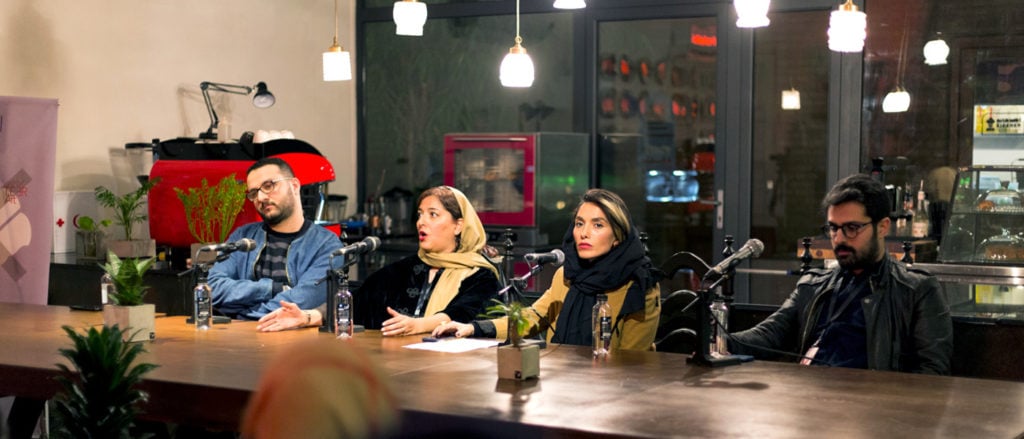
The panel of judges at the TEER Art Fair. Courtesy of TEER.
Although art, which is classified as "advisory textile," is technically exempt from sanctions, the situation poses smashing obstacles for the land's artists and galleries, who remain unable to receive money into their Iranian banking concern accounts.
But those agile in the Iranian fine art scene are going to great lengths to go along the flow of art and ideas moving. Iranian artists continue to participate in blockbuster shows internationally: a number of them are included in the exhibition " Urban center Prince/sses: Dhaka, Lagos, Manila, United mexican states City and Tehran ," which opens June 21 at Paris's Palais de Tokyo, and Iran launched its pavilion at the Venice Biennale terminal month. Meanwhile, the second edition of the Teer Fine art Fair will render to Tehran from June 24 to 28, showcasing 19 Iranian modern and gimmicky fine art galleries—9 more than than its inaugural year.
The Struggle to Make a Living
As a consequence of sanctions, Iranian artists, gallerists, and collectors must navigate a complex labyrinth of global transactions in guild to receive money for their art. Artists without international bank accounts must oftentimes pay boosted fees to bring coin in through so-called exchange companies. Artists with foreign bank accounts, meanwhile, struggle to greenbacks checks abroad with Iranian passports. Sometimes, an artist volition fly to collect the money from a gallery and bring it back to Iran physically.
Iranian artist Sahand Hesamiyan had to await until his dealers, Franz and Heidi Leupi of the Swiss gallery AB Fine Fine art AG (formerly AB43 Contemporary) , traveled to Tehran so they could pay him for the sale of two of his works in greenbacks. Another creative person who works with the gallery, Fereydoun Ave, says he is still owed more than than $60,000 for several sales, fifty-fifty later on repeated follow-ups and lengthy correspondence. (In a letter to several artists awaiting payment, the gallery blamed "extreme regulations on the part of the banks in Switzerland." When reached for comment by artnet News, Franz Leupi said that "in the time to come, we will no longer work with artists from Iran.")
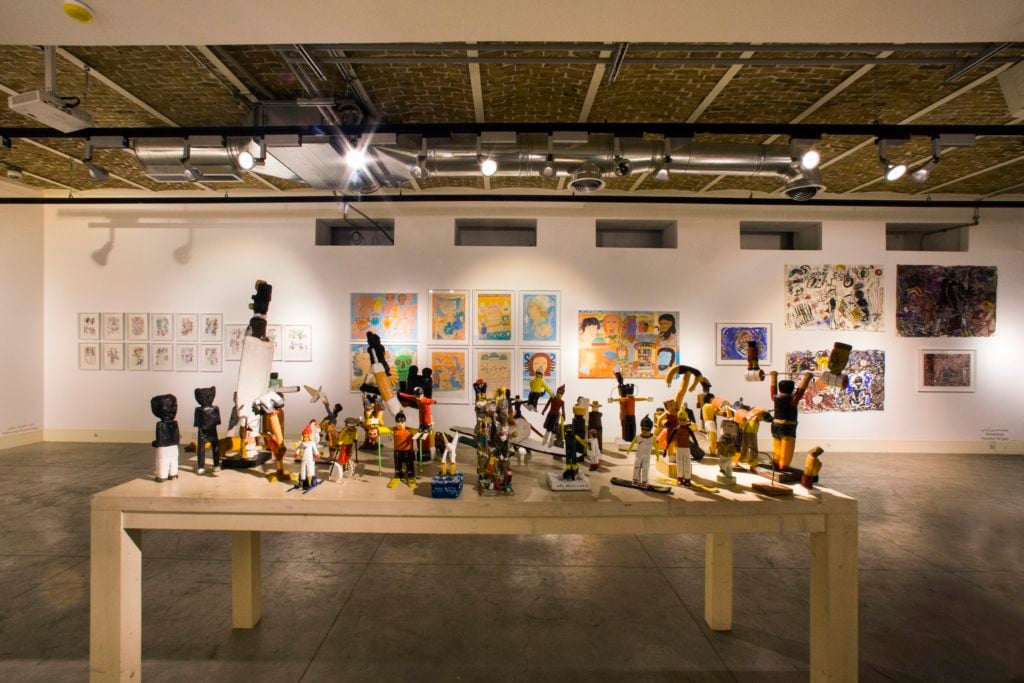
Installation view of Dastan's Basement presentation at the 4th Almanac Outsider Art Exhibition. Courtesy of Dastan's Basement.
Inflation has also made it difficult for artists to fund their day-to-day work. "From the cost of materials and their availability to the increased living costs, information technology is not the best time for production," said the founder of Tehran's contemporary art gallery Dastan's Basement, Hormoz Hematian.
Meanwhile, the cost for local galleries to participate in major fine art fairs has skyrocketed for dealers who must pay with devalued currency, while security checks often filibuster shipments and staff are often unable to obtain visas. While Hematian spends a significant corporeality of time exhibiting at art fairs effectually the globe, such every bit Art Basel and Frieze, "nosotros are certainly non able to do every bit much every bit nosotros potentially could or did before," he said.
The Struggle to Prove
While artists struggle to be paid at home, Iranian curators face a different challenge: organizing shows abroad in countries that are unable to take their coin. Iran's pavilion at the Venice Biennale is an example of the superhuman conclusion required to present Iranian fine art to the world today.
The Tehran-based curator Ali Bakhtiari, who organized the pavilion, had to carry lots of cash with him to Venice in order to pay his staff, his hotel, and other expenses since Iranian bank accounts practise not work abroad. H due east spent a month looking for an insurance company before he found i that would concur to piece of work with him. "Nosotros have been labeled equally terrorists by US regime and it was very important to exhibit in Venice with a message of peace and a belief in a better future," he said.
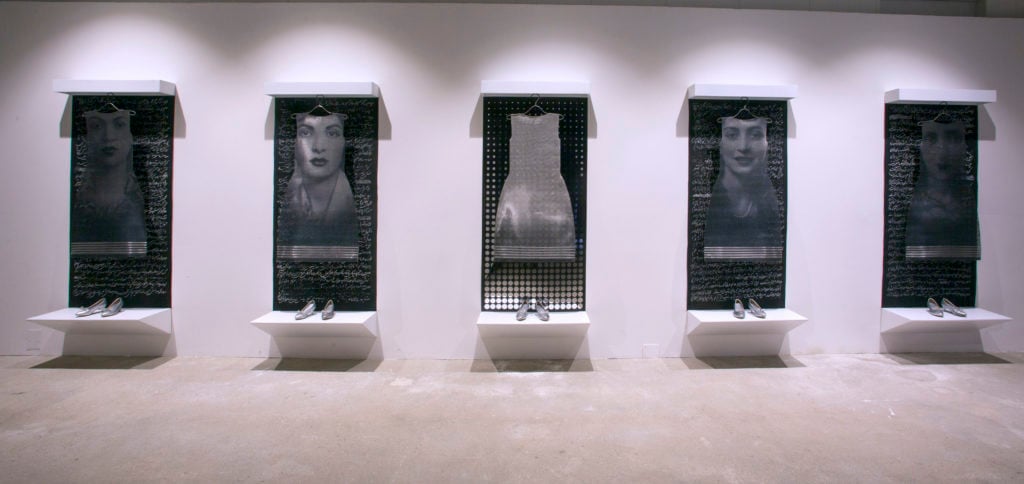
Installation view of piece of work by Samira Alikhanzadeh at the Islamic republic of iran Pavilion. Courtesy of the artists.
Similarly, the London-based nonprofit Parasol Unit had to rapidly adapt to new regulations when sanctions were reimposed well after the group had begun planning an exhibition of piece of work by nine Iranian artists in Venice to coincide with the Biennale.
"I called all of my staff into a meeting and told them that regardless of what is taking place we needed to do everything in our ability to abide by correct measures," says Iranian-born founder Ziba Ardalan. That meant booking artists' tickets from London and reserving them rooms in Venice rather than wiring money to them to brand their own arrangements, among other adjustments. In the terminate, ii artists were however denied visas to the UK to attend the opening of the London branch of the exhibition.
The Struggle to Purchase
The difficulty of moving money in and out of the country has also severely hampered Iran's art market. "We have no clients abroad due to the sanctions," said Shirin Partovi, founder and director of Tehran'due south Shirin Art Gallery. "We have local clients only."
"The situation is becoming really very hard," says an anonymous Dubai-based Iranian collector. "I cannot send money even from a UAE bank account away considering I have an Iranian name." In order to pay for his artwork from Islamic republic of iran, the collector uses substitution houses, a service Iranians have long employed to send or receive money. Merely they have recently become so expensive that they are no longer cost-effective for transactions less than $20,000.
Some galleries are engaging in artistic deals with patrons in lodge to keep their businesses afloat. A leading gallery in Tehran recently inked a deal with the Dubai-based collector Mohammed Afkhami to purchase a number of works—priced between $2,000 and $3,000—for a set budget over the next six to 12 months. (He is paying with money he already has in the country.)
"They told me that I would really help the market and would be doing a great service to Iranian artists if I was seen as actively ownership again," he said. "So we agreed to add at least 50 Iranian artists from the 1940s to the present to my foundation's collection."
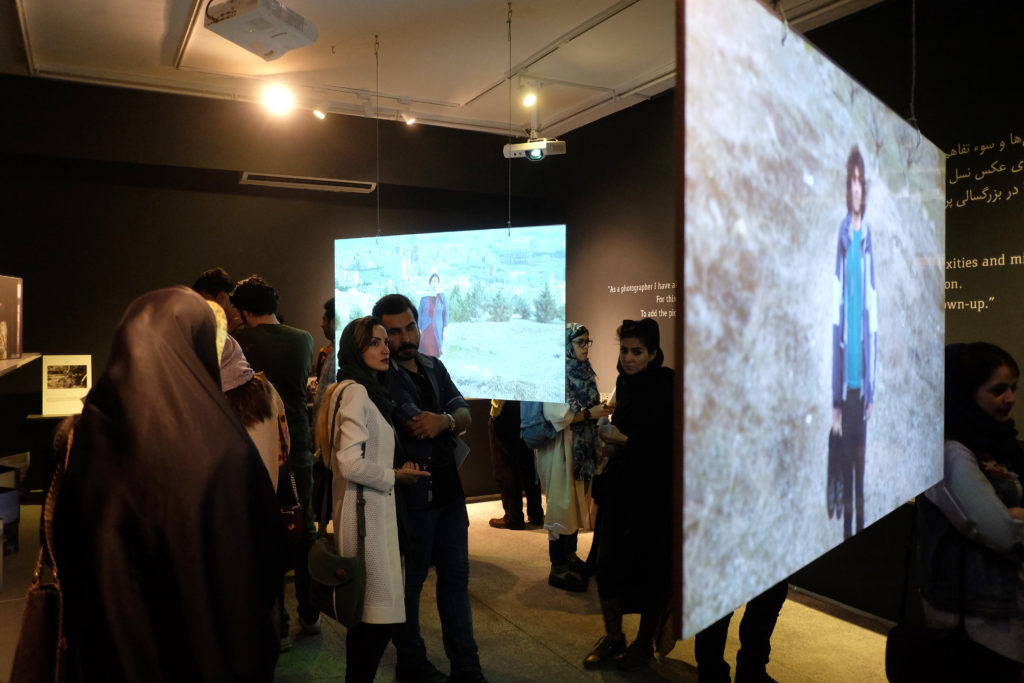
Visitors at a show past Iranian photographer Newsha Tavakolian in Ab-Anbar Art Gallery in Tehran, Iran. AB-ANBAR is an independent space in Tehran, committed to discovery and experimentation of contemporary art in Iran. (Photo past Kaveh Kazemi/Getty Images)
But while it is difficult for many collectors outside Islamic republic of iran to buy art from the state, the fine art trade has likewise go a pop way for wealthy Iranians to motility money out . This January at the tenth Tehran Sale, a piece of work past the late Iranian artist Monir Shahroudy Farmanfarmaian hammered at 40 billion Rials ($400,000), setting a new sale record for the creative person.
"Who knows where the money went?" said one Dubai collector. "It could have stayed in Iran or it could take been sent away. This is a light form of coin-laundering simply information technology is how some people are surviving." Oftentimes, works will accomplish large prices in Tehran and then be sold at a gallery or an auction house abroad in dollars or euros and deposited into a foreign banking company account.
Alireza Sami-Azar, the founder of Tehran Auction, said "it is possible that the works are being resold abroad but we don't accept any concrete examples. What is fact is that… it'due south much amend to buy at the Tehran Sale than to sell. Our main target is to boost the domestic market in order to support the foreign market of Iranian art."
Sanctions, Stereotyping, and Resilience
The sanctions are also having a less applied, but no less insidious, personal bear on on Iranian artists: isolation.
"T he actually sad matter for me is to witness how the word 'Iran' has often become a synonym for paranoia," said Geneva-based independent curator and art consultant Dina Nasser-Khadivi. "This leads to either not wanting to deal with anything that has to do with Iran or to Iranians having to work 10 times harder to find legal loopholes in order to become things done. Either way this situation oftentimes leads to discouraging people within and outside the land."
She points to a collector in Paris who was unable to receive a work of art she purchased from an creative person of Iranian origin later the collector'southward bank declined to pay the shipping visitor. "Their compliance team had Googled the artist and seen that he was originally from Iran," Nasser-Khadivi said.
Meanwhile, iv years agone, the UK-based art nonprofit Magic of Persia, which supports emerging Iranian artists, had to change its name to the MOP Foundation. "Barclays Bank closed our account considering of the word 'Persia,'" said founder Shirley Elghanian.
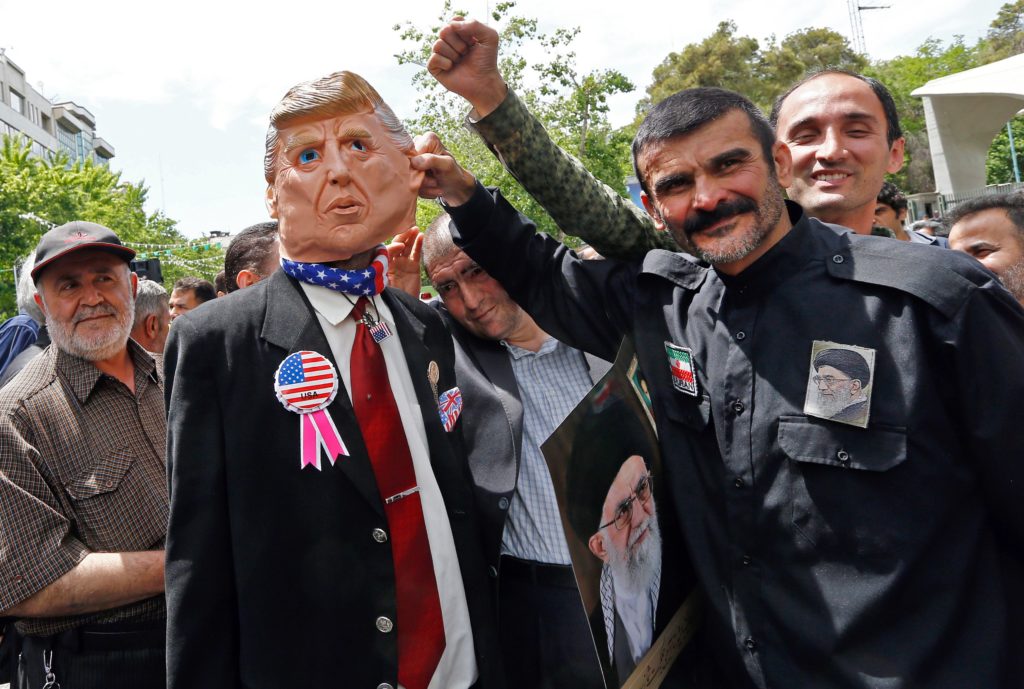
Iranian demonstrators behave a portrait of Islamic republic of iran'south Supreme Leader Ayatollah Ali Khamenei and an effigy of US President Donald Trump during a rally in the capital Tehran. (Photo by STR / AFP/Getty Images)
Against all the odds, even so, the Iranian art scene continues to exhibit remarkable resilience. The show has gone on—inside and outside of the country.
Hematian of Dastan's Basement encourages travelers to visit the country, where they can assist " build infrastructure and exist ready for the twenty-four hours that Iran finds its identify back into the global community." They can too go abode with affordable art. "What $ten,000 can purchase is near quadruple to what information technology would accept been xv months ago," he noted. " I think this is a actually great time to kickoff collecting Iranian art."
"We want the international fine art community to understand that we are all working and so hard," Hematian said. "To say Iran game over is not going to happen. We are going to keep going."
Follow Artnet News on Facebook:
Desire to stay ahead of the art world? Subscribe to our newsletter to become the breaking news, eye-opening interviews, and incisive critical takes that bulldoze the chat frontward.
Source: https://news.artnet.com/art-world/iran-art-scene-sanctions-1575094
0 Response to "Art in Tehran Does Tehran Have an Art Scene"
Post a Comment